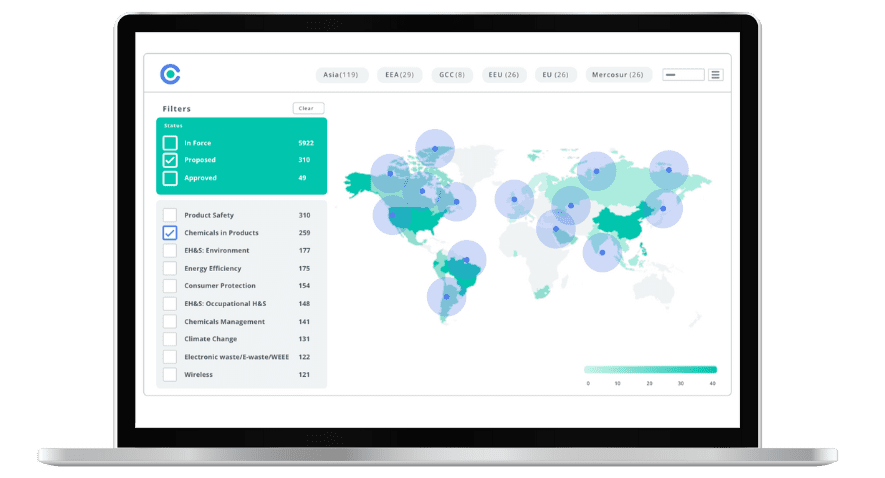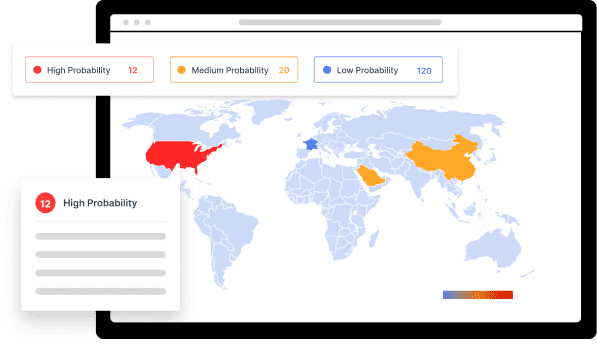
From Complexity to Clarity? EFRAG’s Proposed Simplification of European Sustainability Reporting Standards (ESRS)

This blog was originally posted on 11th August, 2025. Further regulatory developments may have occurred after publication. To keep up-to-date with the latest compliance news, sign up to our newsletter.
AUTHORED BY HANNAH JANKNECHT, REGULATORY COMPLIANCE SPECIALIST, AND CÉLIA LE LIÈVRE, SENIOR REGULATORY COMPLIANCE SPECIALIST, COMPLIANCE & RISKS
On 31 July 2025, the European Financial Reporting Advisory Group (EFRAG) launched the highly anticipated exposure drafts for revised European Sustainability Reporting Standards (ESRS).
The exposure drafts form part of the EU Commission’s Omnibus Simplification Package I, introduced in February 2025. The simplification package aims, among other objectives, to streamline sustainability reporting requirements under the Corporate Sustainability Reporting Directive. If you want to read more about where the EU’s simplification efforts are headed, please consult our update here.
The original ESRS, adopted in Regulation 2023/2772, have been in force since 2023. As part of their ongoing simplification efforts, the EU Commission however tasked EFRAG in March 2025 with developing a simplified version of the ESRS, to be submitted to the Commission by 30 November 2025.
In developing the amended ESRS, EFRAG has consulted with a broad range of stakeholders through a call for input and outreach events, a summary of which can be accessed here. As a result, EFRAG has now published exposure drafts that cut mandatory data points by 57% and the full set of disclosures by 68%.
How is EFRAG Reducing Complexity?
The original ESRS lay out the content of the sustainability reports, and they consist of 12 Standards:
- 2 cross-cutting standards (ESRS 1 on General requirements; ESRS 2 on General disclosures), and
- 10 topicals standards, addressing environmental (ESRS E1 Climate Change, ESRS E2 Pollution, ESRS E3 Water and marine resources, ESRS E4 Biodiversity and ecosystems, ESRS E5 Resource use and circular economy), social (ESRS S1 Own workforce, ESRS S2 Workers in the value chain, ESRS S3 Affected communities, ESRS S4 Consumers and end users), and governance issues (ESRS G1 Business conduct).
The revision aims to uphold the current structure, but it will radically reduce the length of the standards and delete a high number of data points that are considered too detailed. The overall idea is to make the standards more flexible and focused, with narrative disclosures limited to the general requirements standard.
For further insights into sustainability developments across the globe, check out our recent webinars on Asia’s ESG & Sustainability Landscape: Compliance Essentials for 2025 and ESG Regulatory Developments in the US.
What Are the Six Simplification Levers?
During the consultation process, EFRAG identified 6 primary levers for simplification, which have now led to the proposed ESRS amendments below.
Lever 1: Simplification of Double Materiality Assessment
Double materiality assessment (DMA) is a key element of sustainability reporting as it determines whether a sustainability topic (or matter) should be included in the company’s sustainability statement. This process has however been largely criticised for its complexity which often leads to discrepancy in its execution.
To address these concerns, EFRAG suggests taking a top-down approach by clarifying that the assessment should start by a review of the business model to determine the most obvious topics and that the expected level of evidence to support conclusions should be “reasonable and proportionate”, particularly when a topic clearly appears as material.
Differences in how companies factored mitigation and prevention measures to assess the significance (or materiality) of an impact were also observed. The amendment clarifies that the results of any mitigation or prevention measures carried out before the impact can now be considered in the materiality assessment, as long as there is credible evidence that these actions lessen the severity and/or likelihood of potential negative effects.
Last but not least, the criterion of ‘materiality of information’ is refined to serve as a more efficient filter for the inclusion of information in sustainability statements. Assessing whether an information is “material” or significant is now clearly tied to the users’ needs and must be understood as information that could influence decision-making by users of sustainability statements or information that is essential to understand the entity’s significant impacts, risks, opportunities, and how they are managed. This filter will apply to all data points in draft ESRS 2 and topical standards.
Lever 2: Better Readability, Conciseness and Connectivity of the Sustainability Statements
Improving the readability of sustainability reports mainly requires changes to ESRS 1 (General Disclosures). To this end, companies will have the option to publish an ‘executive summary’ at the beginning of their sustainability report and use appendices for more granular or detailed information.
Lever 3: Modification of the Relationship Between Minimum Disclosure Requirements (MDR) and Topical Specifications
EFRAG is proposing major simplifications to the ESRS 2 General Disclosure Requirements and related topical standards by reducing the number of mandatory datapoints and limiting disclosures to essential items. ESRS 2 cross-cutting MDRs are generally proposed to be maintained, but they have been renamed “General Disclosure Requirements” (GDR). One particularly notable reduction concerns the area of mandatory policies, actions and targets (PAT) disclosures. PATs now only need to be reported if they exist, with no requirement to explain their absence, and reporting can be streamlined using tabular formats. In addition, the same PAT across more than one material Impact, Risk or Opportunity (IRO), or topic, can now be reported in an aggregated format.
Lever 4: Improved Understandability, Clarity and Accessibility of the Standards
In order to provide more clarity on the mandatory content of the standards, EFRAG proposes to delete the category of ‘voluntary disclosures’ altogether. The ESRS now only contain mandatory disclosures, while some of the voluntary content, together with information from Q&A documents, has been moved to a document called non-mandatory illustrative guidance (NMIG). The NMIG is a collection of recommended, but not compulsory, examples and explanations designed to help companies understand and apply the reporting requirements, covering all 12 ESRS. An exception has only been made for the non-mandatory Appendix A, which will remain in Amended ESRS 1 General requirements due to its importance.
Lever 5: Introducing New Transitional Reliefs Based on IFRS’s Standards
Lever 5.1 – Undue Cost and Effort
EFRAG proposes to extend the use of the “undue cost and effort” relief mechanism – already present in the IFRS standards – to areas beyond the scope of environmental topical standards. These areas include materiality assessment, the scope of the value chain and the disclosure or presentation of quantitative financial impacts. In short, the undue cost and effort exemption enables companies to base their disclosures on “reasonable and supportable information” that is available to them at the reporting date, provided that acquiring it does not involve excessive cost or effort.
ESRS currently restricts the use of the “undue cost and effort” relief to disclosures related to upstream and downstream value chain information (as outlined in ESRS 1 Appendix 1, AR 17) and the presentation of qualitative information on expected financial effects within specific environmental standards, including pollution, biodiversity and circular economy (Disclosure Requirements E2-6, E3-5, E4-6, E5-6).
EFRAG now plans to expand this exemption to cover not only information about a company’s value chain but all metrics in the ESRS standards. Regarding what constitutes “undue cost and effort”, EFRAG explains that this concept depends on the company’s specific circumstances and requires a balanced evaluation of the costs and efforts involved versus the benefits the information provides to users. According to EFRAG, extending the use of the “undue cost and effort” relief will improve interoperability with the IFRS standard. However, applying this principle to all metrics could also undermine the goals of the CSRD, which seeks to enhance the transparency and quality of information on companies’ sustainability performance. The “undue cost and effort” exemption might have the opposite effect of allowing companies to withhold certain information if they believe that the expense of obtaining it is too high or that the benefits of disclosure do not justify the costs.
Note that information related to financial reporting, operation of business model, strategy, due diligence, and impact management is automatically considered in the draft ESRS as readability available without excessive costs. As such, this information must be considered in the company’s DMA (para. 47 of revised ESRS 1).
Lever 5.2 – Additional Reporting Reliefs
In addition to the broader introduction of the ‘undue cost and effort’, the EFRAG is considering specific reliefs for:
- The disclosure of anticipated financial effects: EFRAG proposes to either a) remove the obligation to report quantitative information (or limiting it to voluntary reporting), or b) require both qualitative and quantitative information but applying the IFRS exemption, which allows reporting only qualitative information when estimation uncertainty is so high that the resulting information would not be useful.
- Exclusion of non-material activities from calculations of metrics where, due to their nature, they are not expected to be drivers of material IROs.
- Relief for acquisitions and disposals, allowing companies to defer the inclusion of newly acquired subsidiaries or businesses in their materiality assessment and sustainability statements until the next reporting period (following the acquisitions).
- Reporting only on a partial scope when data lacks quality (companies should provide transparency on this circumstance and on actions to increase data availability over time).
- Clarification of reporting boundaries, including through clearer distinction between what relates to own operations versus to the value chain.
- A potential relief for commercially sensitive information is also being discussed as part of the Omnibus proposal to revise the CSRD.
Lever 6: Enhanced Interoperability With the ISSB Standards
EFRAG seeks to achieve greater interoperability with the IFRS standards by:
- Placing greater emphasis on the concept of “fair presentation”: this concept requires a “faithful” representation of sustainability-related risks and opportunities. Fair presentation means that sustainability reporting is not a simple compliance exercise: it requires information that is relevant, comparable, verifiable, timely, understandable and fairly presented for all stakeholders.
- Making it clear that the boundary for disclosing GHG emissions should now only be the perimeter of the consolidated financial statement, in line with the GHG Protocol. As currently drafted, ESRS E1 requires reporting the sum of emissions from entities in the financial consolidation boundary (financial control) as well as emissions from entities that fall under the group’s operational control. If the financial consolidation approach is maintained, the requirement to separately break down Scope 1 and 2 GHG emissions between the consolidated group and other investees would need to be removed as no longer necessary after the reporting boundary aligns with the consolidation perimeter.
- Introducing the concept of “Materiality of Information” as a filter for all reported information.
- Embracing the IFRS reliefs (i.e. “undue cost and effort”, disclosures of ranges for quantitative financial effects instead of exact numbers), albeit with limited exclusions for commercially sensitive information and Scope 3 GHG emissions.
- Adopting the same wording as in IFRS S1 and S2 across all ESRS.
What Changes Are Proposed to the Topical ESRS?
EFRAG furthermore proposes the following core changes to the content of the topical ESRS:
- ESRS E1 (Climate Change): Less detail on how targets are set and monitored, while maintaining disclosure of scope 3 emissions and rigour around the definition of gross climate targets.
- ESRS E2 (Pollution): The reference to the European Pollutant Release and Transfer Register (E-PRTR) regulation was deleted from the mandatory requirements, avoiding challenges for non-EU locations. Requirements on substances of concern now focus on manufacturers and importers, while users can focus on substances of very high concern.
- ESRS E4 (Biodiversity): Disclosures of Biodiversity Transition Plans is now mandatory (if material), but only necessary if the company has such a plan in place.
- ESRS E5 (Circular Economy): For in-flows, ‘key materials’ can now be defined based on strategic importance, and for outflows, disclosures on durability and repairability are now narrative.
- ESRS S1 (Own Workforce): Some datapoints were considered too granular and have been deleted, while certain definitions e.g. for adequate wages, have been updated. EFRAG will potentially make further changes to this standard after obtaining stakeholder feedback.
What Other Standards Are EFRAG and the Commission Working On?
Voluntary SME Standards (VSME)
While the ESRS provide the foundation for sustainability reporting for all companies within the scope of the CSRD, they do not apply to non-listed small and medium-sized companies (SMEs), who are not covered by the CSRD. For non-listed SMEs, the EU Commission has however adopted a recommendation for voluntary sustainability reporting.
This recommendation, adopted on 30 July 2025, aims to enhance the comparability of sustainability information disclosed by SMEs, and simplify their responses to data requests from larger companies in their supply chains.
Consequently, the recommendation is also relevant for larger companies and financial institutions, which are strongly encouraged to limit their data requests to SMEs to the information set out in the recommendation whenever possible. Additionally, as part of the Omnibus ‘Content Proposal,’ the Commission has introduced a ‘value-chain cap’ intended to make such limitations on data requests mandatory. Further adjustments to the recommendation’s content are expected after the adoption of the ‘Content Proposal.’
Sector-Specific Standards
The current text of the CSRD requires the EU Commission to adopt a set of sector-specific standards for certain high-impact sectors such as oil and gas, agriculture and textiles. The Omnibus ‘Content Proposal’ however proposes to eliminate the requirement for sector-specific standards altogether. Even though the content proposal is currently still under negotiation, EFRAG has now paused its work on the sector-specific standards, pending the outcome of the legislative process.
ESRS for Non-EU Companies
Based on the CSRD, the EU Commission is also required to adopt a second set of ESRS for non-EU companies in scope of the CSRD, the so-called NESRS. The Omnibus Package does not contain any proposed changes to the adoption of NESRS. EFRAG published a first NESRS draft in February 2025, but has since paused its work on the NESRS to focus on the ongoing revision of the ESRS. Once this is completed, EFRAG will launch a public consultation on the NESRS exposure drafts.
What’s Next?
EFRAG has now launched a 60-day public consultation on the exposure drafts of the simplified ESRS, ahead of their formal submission to the EU Commission in November. The consultation period runs until 29 September 2025. Stakeholders are invited to provide their feedback by completing the survey available here.
To encourage meaningful and robust dialogue, EFRAG will host and co-host outreach events throughout September and October, collecting additional input to inform its final technical advice to the European Commission.
Stay Ahead Of Regulatory Changes in European Sustainability Reporting Standards
Want to stay ahead of regulatory developments in European Sustainability Reporting Standards?
Accelerate your ability to achieve, maintain & expand market access for all products in global markets with C2P – your key to unlocking market access, trusted by more than 300 of the world’s leading brands.
C2P is an enterprise SaaS platform providing everything you need in one place to achieve your business objectives by proving compliance in over 195 countries.
C2P is purpose-built to be tailored to your specific needs with comprehensive capabilities that enable enterprise-wide management of regulations, standards, requirements and evidence.
Add-on packages help accelerate market access through use-case-specific solutions, global regulatory content, a global team of subject matter experts and professional services.
- Accelerate time-to-market for products
- Reduce non-compliance risks that impact your ability to meet business goals and cause reputational damage
- Enable business continuity by digitizing your compliance process and building corporate memory
- Improve efficiency and enable your team to focus on business critical initiatives rather than manual tasks
- Save time with access to Compliance & Risks’ extensive Knowledge Partner network

Simplify Corporate Sustainability Compliance
Six months of research, done in 60 seconds. Cut through ESG chaos and act with clarity. Try C&R Sustainability Free.



